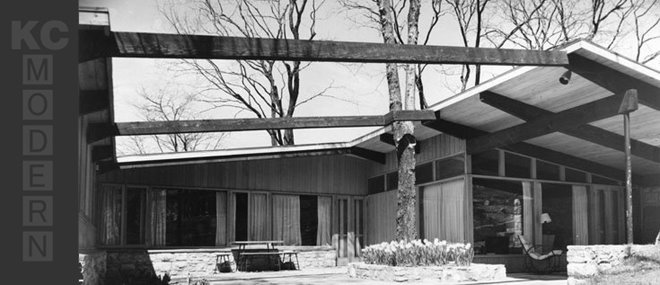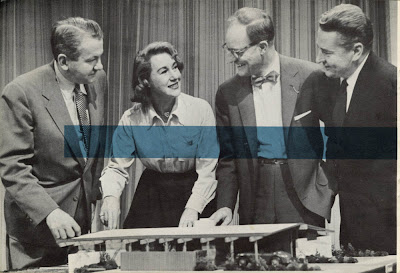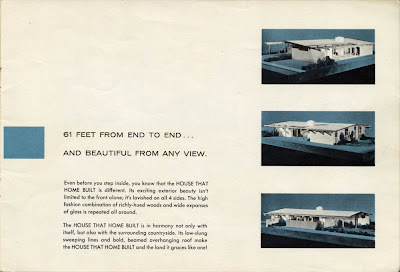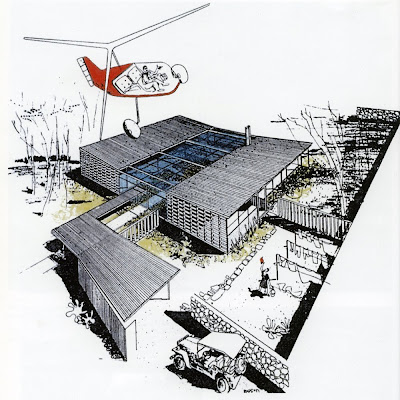In 1955 a popular TV show convinced builders across the country, including Kansas City’s own Don Drummond, to try their own Eichler homes
By Robert McLaughlin - originally written for the Eichler Network Newsletter

Arlene Francis displays a scale model of 'The House that HOME Built' on NBC-TV network show, 'HOME.' Image courtesy of NAHB Archive, NAHB Correlator, October 1955.
In Northern California,
Eichler homes became as much a part of the landscape as chaparral and live oak trees. Except for a handful in upstate New York, and about 750
Eichler look-
alikes in Oregon,
Eichler homes never made much impact on the country as a whole. But for a brief time in the mid-1950s, it looked like they might when builders like Kansas City’s, Don
Drummond began building their own authorized version of the
Eichler home.
In 1955, thanks to a popular NBC television show ‘HOME,’ a design that California architects, Jones &
Emmons originally created for builder, Joseph
Eichler began popping up in 20 or more cities throughout the United States. Jones and
Emmons Architects went on to design the
X-100 and
Case Study House #24 for Joe
Eichler. Each house was built by local merchant builders attracted to the program by the free publicity provided by the popular show, sort of a mid-‘50s
HGTV.
One builder who enthusiastically got behind the program was Donald
Drummond, the nearest thing Kansas City had to a Joe
Eichler.
‘HOME,’ hosted by Arlene Francis and correspondent Hugh Downs, aired weekdays following NBC’s Today show. It had 2 million viewers, mostly women. ‘The House That HOME Built’ segment, which ran regularly, tried to persuade America that glass-walled, low-gabled, modern homes would work anywhere in the country, not just sunny California.

NBC 'HOME' Logo, 1955. Image from HTHB Brochure courtesy of Scott Butterfield.
The ‘House That HOME Built’ was co-sponsored by NBC and the National Association of Home Builders. Housing expertise was supplied by C.W. Smith, director of the Southwest Research Institute’s Housing Research Foundation.
“We recognize that regional preferences exist,” Smith told House and Home magazine in an April 1955 story, “but we want to show people that steep roofs, small windows and basements in the northeastern part of the country are due entirely to prejudice and habit and are entirely unnecessary technically as well as undesirable from a performance standpoint.”

Rendered image of the 'HTHB' from Pacific Architect and Builder Magazine, April 1955. Courtesy of the A. Quincy Jones Archive and Elaine Jones.
Each builder paid $200 for the plans and agreed to build one model to be open to the public. A June 4, 1955 deadline was set to coincide with ‘HOME’s national publicity.
The program was likely the brainchild of
Eichler, who hoped the buzz generated by the show would promote his own houses. According to the April 1955 article in House and Home,
Eichler and Smith persuaded Quincy Jones and Frederick
Emmons to design the house. In truth,
Eichler had been building early versions of the Jones and
Emmons design since 1953.
The producers mandate to Jones and
Emmons was to design a house appropriate for any climate that could be constructed by builders anywhere in the United States. The program’s goal was to show “that an attractive, up-to date house, embodying principles of good design, can be built at a moderate cost.”
Promotion began when a model of Jones and
Emmons’ design appeared on the show, which was broadcast from New York, on Feb. 28, 1955.

On the of the NBC set presenting a model of 'The House that HOME Built' with R.J. Caravan of the National Association of Home Builders; Arlene Francis, star of 'HOME'; C.W. Smith housing authority on 'HOME' and director of the Housing Research Foundation of the Southwest Research Institute; and A. Quincy Jones, architect of 'The House that HOME Built'. Image from Pacific Architect and Builder Magazine, April 1955. Courtesy of the A. Quincy Jones Archive and Elaine Jones.
Jones realized that what worked for buyers in California might face resistance elsewhere. “We are going to be criticized that it is extreme, but it’s not,” he said. “Almost everything that’s in here we’
ve been doing for 10 years.”
Eichler appeared on the show with Illinois builder Bruce
Blietz two days later, and
Drummond appeared March 25. Commercial television was less than a decade old, but both builders understood its power. “I figured I had about five minutes to sell a thousand houses,”
Drummond recalled in a recent interview.

NBC 'HOME' Studio in New York City, 1955. Image from HTHB Brochure courtesy of Scott Butterfield.
‘The House that HOME Built’ was a typical Jones H-plan, with two terraces defined by exterior walls. Kansas City
Drummond owners call them “side
atriums.”
One terrace is adjacent to the public entrance. The other is a private outdoor living area. An open kitchen-living area forms the center of the house, connecting the two legs of the H. Bedrooms fill the rear leg, while a carport and “all-purpose room” fill the front leg, which faces the street. The bi-nuclear plan successfully separates living and sleeping areas.
The roots of the home can be found in some of Jones &
Emmons earlier plans for
Eichler, including the
JE- 15,
JE-35,
JE-51 and the
JE-85.

'The House that HOME Built' Plan Courtesy of the A. Quincy Jones Archive and Elaine Jones.
A
JE-85 clone appears in House and Home magazine in July 1955, and seems to be the immediate predecessor to ‘The House That HOME Built,’ Ernie
Braun’s photos for the article were dated April 1955, establishing it as finishing just as the NBC program was starting. Jones and
Emmons had designed more than 200 plans for
Eichler by 1955 and ‘The House That HOME Built’ seems to be the pinnacle of this particular plan type. Soon
Eichler’s focus would shift to the atrium plan.

Joseph Eichler's JE-85 on the cover of the House+Home Magazine, July 1955.
Unlike earlier
Eichlers the post and beam frame and fascia of ‘The House That HOME Built’ extended past the roof eaves to form a trellis-like overhead structure on the side terraces.

Image announcing 'The House that HOME Built' program from House+Home Magazine, April 1955.
Two things Jones thought unusual were the location of the laundry between bedrooms, and a built-in dining table with two built-in burners and an oven at the end. Jones had recently designed a similar prototype kitchen for Frigidaire. A table
cooktop was also included in Jones’ own steel house and the X-100 prototype steel house that he did for
Eichler a year later.

Rendering of 'The House that HOME Built' kitchen. Image from HTHB Brochure courtesy of Scott Butterfield.
The most notable refinement to the new plan was a sliding glass door between the kitchen and terrace. “This blew the whole center of the house open,” says Scott Lane, a Kansas City real estate broker and
Drummond enthusiast. Other changes included the substitution of a carport for a garage and revised bathroom locations. Many builders went ahead and included a garage in this house that was already rather luxurious for the time.
Eichler and
Drummond were masters of merchandising. It is no coincidence that the kitchen, baths and laundry were the focus of changes to the plan. This reflects the power women were gaining over such major decisions as buying a house.
Not relying solely on NBC’s ‘HOME’ to reach would-be buyers,
Drummond had a local cooking show broadcast from the kitchen of his model home. The show promoted appliances that could be purchased with the home.
“There was a nice little profit to be made from the sale of these appliances with the house,”
Drummond says.
Some of the builders who took on ‘The House that HOME Built’ challenge may have been nervous about the home’s modern touches. But not
Drummond. Unlike most of the builders, who constructed only one home,
Drummond was soon building several.

Bruce Blietz of Illinois had clocked nearly 10,000 visitors to his "HTHB" and garnered new prestige for his firm. Image courtesy of NAHB Archive, NAHB Correlator, October 1955.
Drummond was unsure about one aspect of the house – the master bedroom’s sliding glass door. But he was overruled by his wife and business partner, Frances
Drummond, who was responsible for
Drummond’s career-making decision to hire a real architect to design his homes. “
Francie thought it was a good idea, so we kept it. She thought it would appeal to the women.”

Don Drummond expected to net about forty sales from his showing of the house on Canterbury Street in Prairie Village, Kansas. Image courtesy of NAHB Archive, NAHB Correlator, October 1955.
Cleveland builder, Peter
Krutschnitt modified the plan, probably to deal with harsh winters. As seen in a 1955 advertisement for
Fenestra Windows, the house was rotated so its entry faced the street, something
Drummond did as well. The carport was replaced by a garage, and the roof overhangs were extended to provide protection for rafter ends. It appears that many builders placed the home on corner lots to allow the homes side entry to face the street.

Peter Krutschnitt 'HTHB' in a Fenestra Window Advertising Image from House+Home Magazine, September 1955.
By late spring the publicity for the homes was beginning to crescendo. The June 1 episode of ‘HOME’ featured a segment showing Thomas Church, one of the founders of modern landscape architecture, preparing planting designs for
Eichler. And across the country, builders were hustling.
“My father had workmen working day and night the last two weeks of the project,” says Henry
Schwier Jr., the son of New Jersey builder Henry
Schwier.

Henry Schwier of Sea Girt, New Jersey set his model on a 1/4 acre waterfront lot and kept it open for several months. Image courtesy of NAHB Archive, NAHB Correlator, October 1955.
On June 3, the day before the homes’ public opening, the entire show was devoted to ‘The House that HOME Built,’ beginning with a race between movers in San Francisco, Chicago, Kansas City, and Denver to outfit the homes with model furnishings. Afterwards, the builders were interviewed about their models.

In Flint, Michigan, Robert Gerholtz drew record crowds and wanted to participate again in 1956. Image courtesy of NAHB Archive, NAHB Correlator, October 1955.
Not every builder, however, crossed the finish line by June 4. Some builders blamed the delays on a late spring. Others had trouble getting FHA approval for loans.
Eichler and
Drummond finished their houses on time along with at least seven other participants.
Eleven builders were given a second deadline, Sept. 10, during National Home Week. All of the latecomers who finished for this deadline were from Northern States.

C.B. Rogers tallied 4500 visitors on opening day alone. Image courtesy of NAHB Archive , NAHB Correlator, October 1955.
Most of the builders did well thanks to the program.
“Eleven sales consummated, $242,000 volume,”
Drummond telegraphed ‘HOME’ in late June. “Thirty sales in process of being signed, at $720,000. Three weeks after ‘HOME’ promotion, sales response becoming stronger daily. Public thinks house is wonderful. It is affecting the desire to buy… Combined promotional effort is now snowballing. Market appears unlimited here. Will appreciate the opportunity to cooperate with ‘HOME’ in any way.”
Eichler Homes had similar news to report. “Sixteen houses sold in four locations,” a telegram from D.L.
Stoffe read. “Total of 61 various houses sold within the four developments. Attendance in first twelve days approximately 10,000. Public response excellent. Sizable coverage of story in all San Francisco newspapers and many others in Northern California.”

M.C. (Marcus) Bogue of Denver, Colorado greeted a few of the 22,000 people who turned out for his opening of the "HTHB". Image courtesy of NAHB Archive, NAHB Correlator, October 1955.
As it turns out, ‘The House that HOME Built” was unable to ignite a nationwide desire to live in
Eichler-style homes.
By October 1955, ‘HOME’ was planning new programming for 1956 with New York architect, Eldridge Snyder, designing three less modern models for builders to choose from, including ranch and split level homes.
Drummond built one of the single level designs at 98
th Place, but it is assumed that
Eichler did not participate in the second program.

Architect, Eldridge Snyder's Celebrity 1956 HTHB Model had 1325 sq.ft. with two bedrooms, three baths and fit on a 60' lot. This model was built by Don Drummond at 98th Place in Overland Park. Image from House+Home Magazine, October 1955.

New York Architect, Eldridge Snyder's 1956 "HTHB" Spacesetter split-level model had five bedrooms, three baths and a laundry.
By the late ‘50s, romantic styles trickled into shelter magazines, crowding out the modern. For some builders, ‘HOME’ was their first and only foray into modern design. For
Drummond, however, the program was just one step in a career largely devoted to modern home
construction.
Today, although “
Drummonds” have not achieved the mythical status of
Eichler homes, they have a dedicated, cult-like following of artists, designers,
realtors and architects who appreciate their open plans, post-and-beam structure, and expansive glass.
 KCMODERN friend, Scott Butterfield did some serious scan work of 'The House that HOME Built' brochure to let us share it with our readers. The promotional brochure was designed and printed by NBC for participating builders to use in their marketing of 'The House that HOME Built.' Kansas City Modern Builder, Don Drummond gave the brochure to Scott's parents in 1955, when they were thinking about having Don build them a house. Don Drummond signed the back cover for Scott at a soiree during the Drummond Weekend in 2006.
KCMODERN friend, Scott Butterfield did some serious scan work of 'The House that HOME Built' brochure to let us share it with our readers. The promotional brochure was designed and printed by NBC for participating builders to use in their marketing of 'The House that HOME Built.' Kansas City Modern Builder, Don Drummond gave the brochure to Scott's parents in 1955, when they were thinking about having Don build them a house. Don Drummond signed the back cover for Scott at a soiree during the Drummond Weekend in 2006.

































 Name: Case Study No. 4, Greenbelt House
Name: Case Study No. 4, Greenbelt House














